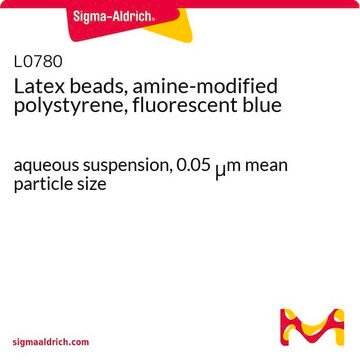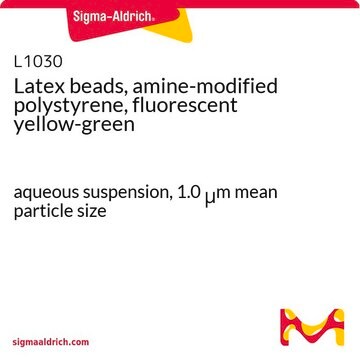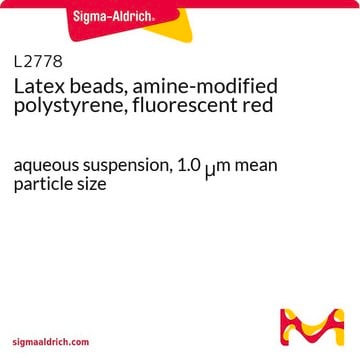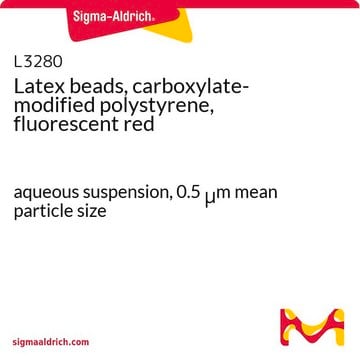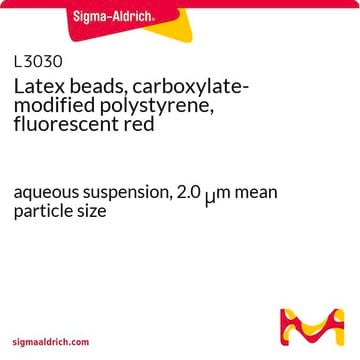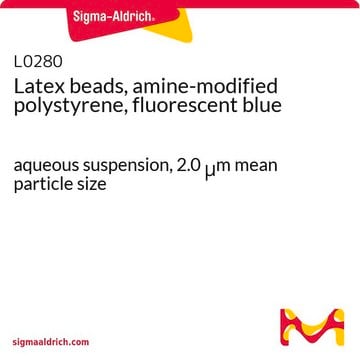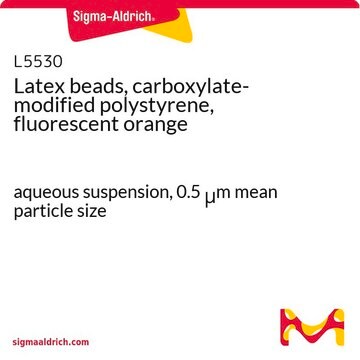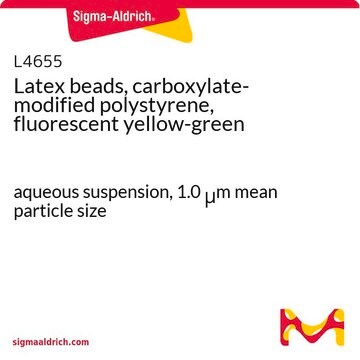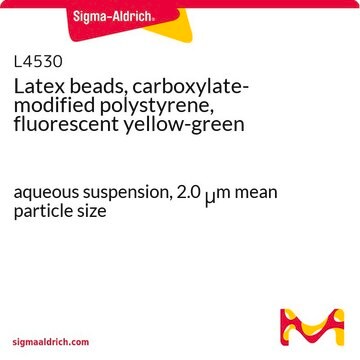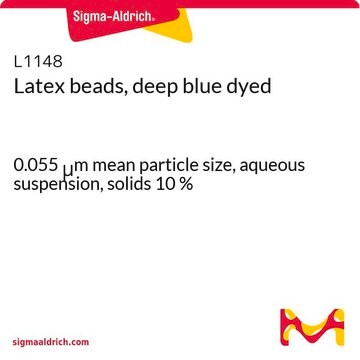L9904
Latex beads, amine-modified polystyrene, fluorescent orange
aqueous suspension, 0.1 μm mean particle size
Synonim(y):
Fluorescencyjne pomarańczowe kulki, Kulki lateksowe modyfikowane aminą
Zaloguj sięWyświetlanie cen organizacyjnych i kontraktowych
About This Item
Polecane produkty
Formularz
aqueous suspension
skład
Solids, 2.5%
metody
cell based assay: suitable
średnia wielkość cząstek
0.1 μm
fluorescencja
λex ~475 nm; λem ~540 nm
Zastosowanie
cell analysis
Szukasz podobnych produktów? Odwiedź Przewodnik dotyczący porównywania produktów
Zastosowanie
Amine-modified polystyrene latex beads have been used to develop an electrochemical nitrite nanosensor as well as to validate a pharyngeal aspiration technique for exposing the mouse lung to respirable particles.
Latex beads, amine-modified polystyrene, fluorescent orange has been used in the preparation of nano-particles in biophysical characterization. It has also been used in the preparation of nano-particles for cytotoxicity studies in yeast and cell lines.
Ta strona może zawierać tekst przetłumaczony maszynowo.
Kod klasy składowania
10 - Combustible liquids
Klasa zagrożenia wodnego (WGK)
WGK 3
Temperatura zapłonu (°F)
Not applicable
Temperatura zapłonu (°C)
Not applicable
Wybierz jedną z najnowszych wersji:
Masz już ten produkt?
Dokumenty związane z niedawno zakupionymi produktami zostały zamieszczone w Bibliotece dokumentów.
Klienci oglądali również te produkty
Edwin H Shin et al.
Nanoscale, 5(13), 5879-5886 (2013-05-24)
The use of nanoparticles for cellular therapeutic or sensing applications requires nanoparticles to bind, or adhere, to the cell surface. While nanoparticle parameters such as size, shape, charge, and composition are important factors in cellular binding, the cell itself must
Exposure of the yeast Saccharomyces cerevisiae to functionalized polystyrene latex nanoparticles: influence of surface charge on toxicity
Nomura T, et al.
Environmental Science & Technology, 47(7), 3417-3423 (2013)
Esen Efeoglu et al.
The Analyst, 142(18), 3500-3513 (2017-08-24)
Nanotoxicology has become an established area of science due to growing concerns over the production and potential use of nanomaterials in a wide-range of areas from pharmaceutics to nanomedicine. Although different cytotoxicity assays have been developed and are widely used
Christiane Höppener et al.
Small (Weinheim an der Bergstrasse, Germany), 16(17), e1907418-e1907418 (2020-04-01)
Understanding the property-function relation of nanoparticles in various application fields involves determining their physicochemical properties, which is still a remaining challenge to date. While a multitude of different characterization tools can be applied, these methods by themselves can only provide
Toshiyuki Nomura et al.
Environmental science & technology, 47(7), 3417-3423 (2013-03-02)
Novel nanoparticles with unique physicochemical characteristics are being developed with increasing frequency, leading to higher probability of nanoparticle release and environmental accumulation. Therefore, it is important to assess the potential environmental and biological adverse effects of nanoparticles. In this study
Nasz zespół naukowców ma doświadczenie we wszystkich obszarach badań, w tym w naukach przyrodniczych, materiałoznawstwie, syntezie chemicznej, chromatografii, analityce i wielu innych dziedzinach.
Skontaktuj się z zespołem ds. pomocy technicznej